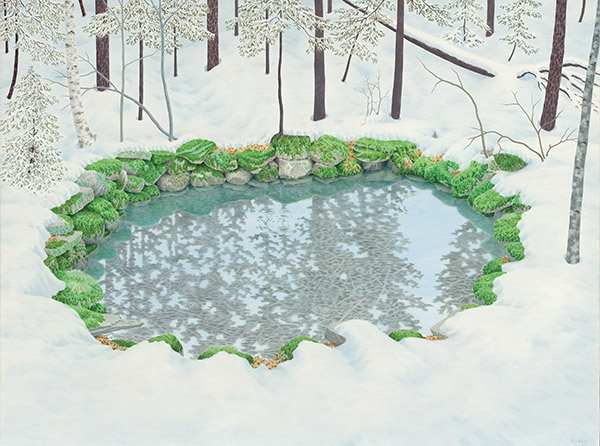Northwoods: Absence and Presence. The Art of Alan Bray and Poetry of Wesley McNair
Monson Arts Gallery, Monson, ME • monsonarts.org • Through October 29, 2023
In a 2009 talk connecting Edward Hopper’s art to literature, Harvard professor Peter Sacks offered various “analogues and oblique illuminations,” parallel aesthetics between his work and the verse of various poets, including Elizabeth Bishop and Robert Frost. This exhibition of paintings by Alan Bray and poems by Wesley McNair underscores that concept: no ekphrastic connection here, just kindred spirits.

By way of eighteen caseins, an oil, a giclée print and a drawing, and nineteen poems (from Late Wonders: New and Selected Poems, 2022), painter and poet present a Maine that lies not off the grid, but pretty close. And they know the territory well: Bray has lived in Sangerville for much of his life while McNair is a longtime resident of Mercer, both hamlets in the state’s hinterlands.
The pairings are inspired. McNair’s “In Praise of a Tree,” a tribute to an ancient white pine that has carried “cargoes of squirrels and song birds,” accompanies Bray’s Uprooted, 1994, a marvelously gnarly and surreal arboreal creation rimed with ice and snow.
Poet and artist make beauty out of the overlooked or unsung. Who could imagine a poem about telephone poles “balancing cables on their shoulders” might be transcendent in its vision? Bray’s Cheese Factory Spring, 2007, depicts a lost woodland watering hole; critic Edgar Allen Beem once called it “the apotheosis” of his “gnostic talent for evoking the hidden narrative of landscapes.”
In a statement for the show, McNair notes that his Maine “features people” while Bray’s “is largely without them.” That said, the individuals that appear in the poem “Seeing Mercer, Maine,” including “the old/man from the coast who built/the lobster shack/in a hayfield,” are kin to the folk who cut the slate that appears in Bray’s Hebron Quarry, 1980.
“Reading Wes’s poems or looking at Alan’s art,” writes curator Stuart Kestenbaum in the exhibition catalogue, “it’s clear…they have taken the time to examine the power of place—how we shape the land and it shapes us.” They also know how to shape our vision of a world through powerful poems and paintings.
— Carl Little
